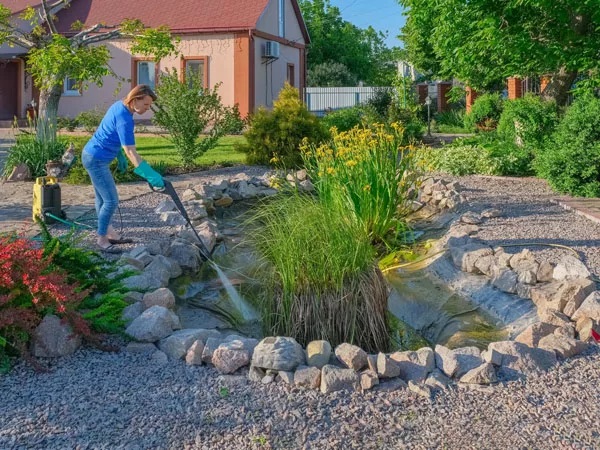
Pressure washing is a great way to refresh walkways, retaining walls, and patios — but when your landscape includes a garden pond, things get trickier. The goal is to clean without sending dirt, debris, or detergent into your delicate aquatic ecosystem. So, how do you clean the surrounding areas safely while keeping your fish friends happy and healthy? 🐠🧼
Let’s walk through everything you need to know.
🐟 Why Garden Ponds Need Extra Care
Fish, frogs, and aquatic plants are extremely sensitive to changes in their water environment. Even small amounts of:
- Soap or detergent residue 🧴
- Concrete or algae runoff 🧱
- High-pressure water flow 💦
- Mud or organic matter 🌿
…can disrupt water quality, lower oxygen levels, or even be toxic to the wildlife in your pond.
That’s why careful prep and technique are essential when pressure washing near ponds. 🎯
🧰 Tools and Setup
Here’s what you’ll need for a safe and effective job:
✅ Pressure washer (preferably under 2000 PSI)
✅ 40° wide-angle nozzle
✅ Eco-friendly, biodegradable detergent (optional)
✅ Tarp or plastic sheeting
✅ Sandbags or pond edging
✅ Wet/dry vacuum or broom for cleanup
Browse Amazon Here For Top Rated Power Washers And Accessories
🛡️ Step-by-Step: Pressure Washing Near a Pond
1. Create a Barrier Around the Pond 🧱
Lay down plastic sheeting or a waterproof tarp around the perimeter of the pond, especially in areas closest to where you’ll be washing. Use sandbags, bricks, or stones to hold it down and prevent runoff from sliding in.
2. Turn Off Pumps and Filtration Temporarily
If your pond has a pump or waterfall, turn it off during cleaning to avoid pulling in any contaminants. Leave it off until after everything is rinsed and safe.
3. Use Biodegradable Cleaning Agents (or None at All) ♻️
If possible, avoid using soap altogether. But if you need help with algae or tough stains, choose a non-toxic, biodegradable pressure washer detergent that’s safe for surrounding plants and wildlife. Always double-check the label.
4. Keep a Safe Distance
Maintain at least 3–4 feet between your pressure washer and the pond edge. Point the spray away from the pond, never toward it.
Use a 40° nozzle to reduce force and keep splatter to a minimum.
5. Work in Sections & Contain Runoff 💦
Clean in small sections and immediately redirect or soak up water using towels, a wet/dry vac, or a broom. Don’t let rinse water flow unchecked into the pond.
If you’re working on sloped terrain, clean from the bottom upward so debris doesn’t trickle downhill toward the pond.
6. Rinse and Inspect the Area
Once you’re done, rinse surrounding plants and walkways with plain water to dilute any leftover soap. Check pond barriers before removing them to make sure no debris slipped through.
💡 What Not to Do
🚫 Don’t use bleach, harsh degreasers, or solvents — even in small amounts
🚫 Don’t clean directly over pond rocks or edges where water flows in
🚫 Don’t leave detergent or wastewater puddling near pond inlets
🪴 Bonus Tip: Use Natural Alternatives
If you’re just removing algae, consider these low-impact cleaning options:
🌿 A mix of white vinegar and water
🧽 A scrub brush with warm soapy water (outside pond zones)
🧼 Steam cleaning (for stubborn grime on flat stones)
These methods reduce the chance of pond contamination altogether.
🐠 After Cleaning: Restore Balance
Once the area is dry and clean:
✅ Remove all tarps and barriers
✅ Turn your pond pump and filtration back on
✅ Watch for any signs of water cloudiness or fish distress
✅ Consider testing your pond water with strips or a test kit (especially if you suspect some runoff entered)
If needed, do a partial water change — usually 10–20% is enough to restore balance without shocking your pond ecosystem.
🌎 Final Thoughts
Pressure washing around a garden pond doesn’t have to be risky. By preparing smartly, choosing non-toxic products, and controlling runoff, you can safely clean your outdoor space while protecting your aquatic life. 💚🐟
Quick Recap:
✅ Use barriers and eco-safe products
✅ Keep your distance from pond edges
✅ Clean in small, controlled sections
✅ Avoid all runoff into the water
✅ Monitor pond health after cleaning
With a little extra care, you can enjoy a fresh, spotless patio and a thriving pond — no compromise needed. 🧼🐠🌿
Browse Amazon Here For Top Rated Power Washers And Accessories






